check engine AUDI S6 2013 Owner's Manual
[x] Cancel search | Manufacturer: AUDI, Model Year: 2013, Model line: S6, Model: AUDI S6 2013Pages: 306, PDF Size: 76.92 MB
Page 231 of 306
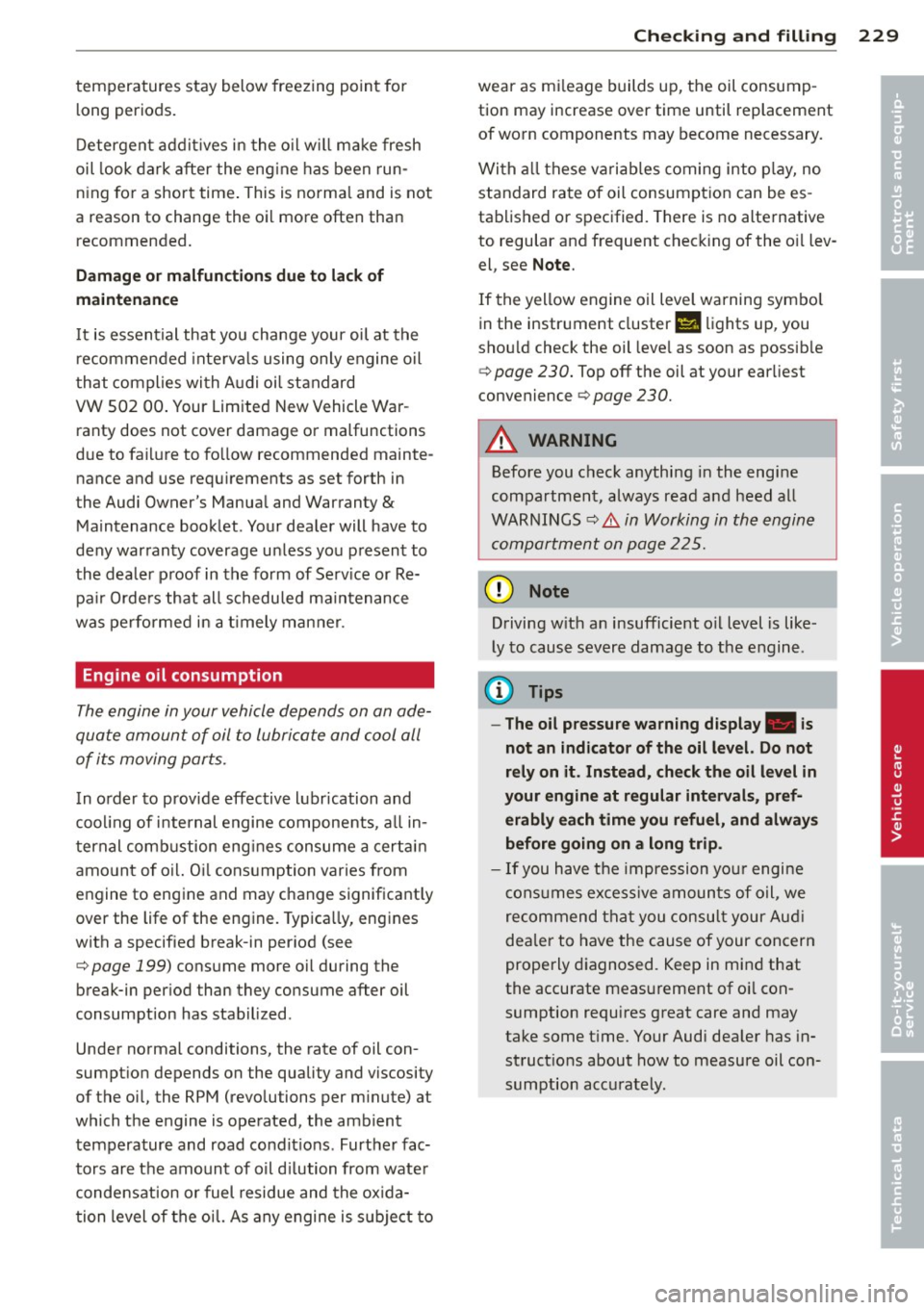
temperatures stay below freezing point for l ong periods.
Detergent add itives in the o il w il l make fresh
oil look dark after the eng ine has been run
ning fo r a short time . This is norma l and is not
a reason to change the oi l more often than
recommended.
D am ag e or m alfun ction s due to lack of
ma intenanc e
It is essential that you change your oil at the
r ecommended inte rva ls using only engine o il
t hat complies wi th A udi oi l standard
VW 502 00 . Your Limited New Vehicle War
ranty does not cover damage or malfunctions
d ue to fa ilure to fo llow recommended mainte
nance and use requ irements as set forth in
the Audi Owner's Manua l and Warranty
&
Maintenance book let . Your dea ler will have to
deny warranty coverage u nless you present to
the dea ler p roof in the fo rm of Serv ice or Re
pa ir Orde rs that all s chedu led maintenance
wa s pe rformed in a t imely manner .
Engine oil consumption
The engine in your vehicle dep ends on an ade
quate amount of oil to lubricate and cool all
of its moving parts.
In o rder to provide effective lubrication and
cool ing of i nternal engine components, a ll in
ternal comb ustion eng ines consume a cert ain
amo unt of o il. Oil cons umption varies from
engine to engine and may change significantly
over the life of the engine. Typ ica lly, engines
with a specified break-in per iod (see
¢
page 199) consume more oil during the
break-in per iod than they consume after oil
consumption has stabilized .
Under norma l conditions, the rate of oil con
sumpt ion depends on the quality and viscosity
of the oil, the RPM (revo lutions per m inute) at
which the engine is operated, the amb ient
temperature and road condit ions. Furthe r fac
tors ar e the amount of o il d ilution from wate r
condensation or fuel residue and the ox ida
tion level of the oi l. As any engine is s ubje ct to
Checkin g and fillin g 229
wear as m ileage builds up, the oil consump
tion may increase over time until replacement
of worn components may become necessary.
Wi th a ll these variab les coming into p lay, no
standard rate of oil consumpt ion can be es
tablished or specified. There is no alternative
to regular and frequent check ing of the o il lev
el, see
Note .
If the yellow engine oil leve l warning symbo l
in the instrument cluster
II li ghts up, you
sho uld check the oil leve l as soon as possib le
¢
page 230. Top off the oil at your earliest
convenience ¢
page 230.
A WARNING
Before you check anythi ng i n the engine
com partment, always read a nd heed all
WARNINGS¢ .&.
in Working in th e engine
c ompartment on page 225.
(D Note
D riving w ith an insufficient o il level is like
ly to cause sever e damage to the engine .
(D Tips
- The oil pressure warning display. is
not an indicator of the oil le vel. Do not
rely on it . Instead, check the oil level in
your engine at regu lar intervals, pref
erably ea ch time you refuel, and always
before going on a long trip .
-If you have the impression yo ur engi ne
c ons umes ex ce ss ive amoun ts of o il, we
recommend that you consul t your Au di
de aler to have the cause of your concern
properly diagnosed . Keep in mind that
the accurate meas urement of o il con
sumption requires great care and may
take some t ime. Y our Audi dea ler has in
struct ions about how to measure oil con
sumption accurately.
-
•
•
Page 232 of 306
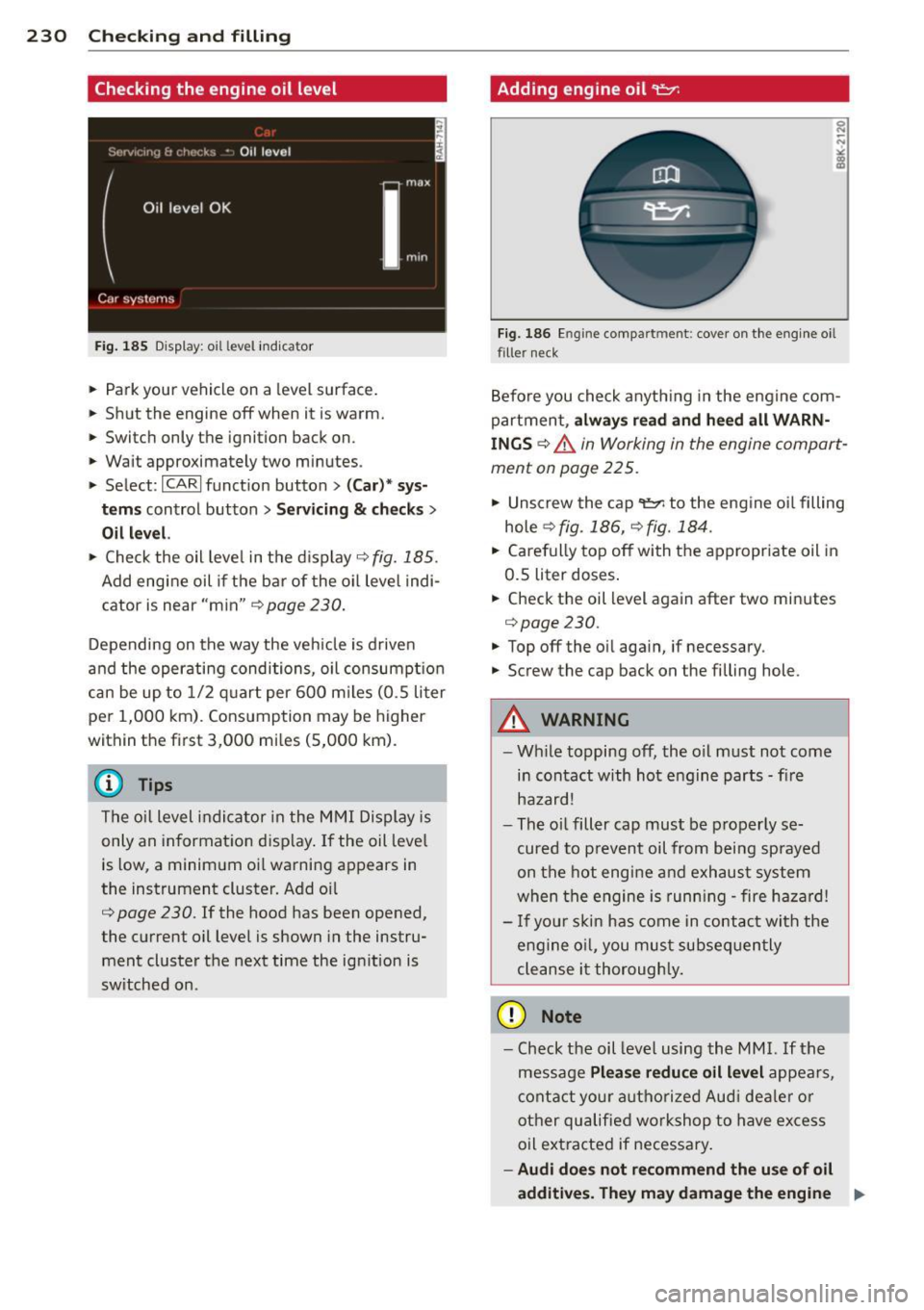
230 Checking and filling
Checking the engine oil level
Fig. 185 Disp lay: o il level indica tor
• Park your vehicle on a level surface.
• Shut the engine off when it is warm.
• Switch only the ignition back on.
• Wait approximately two minutes.
• Select:
ICARI function button> (Car)* sys
tems
control button > Servicing & checks >
Oil level.
• Check the oil level in the display c::> fig. 185.
Add engine oil if the bar of the oil level indi
cator is near "min"
c::> page 230.
Depending on the way the vehicle is driven
and the operating conditions, oil consumption
can be up to 1/2 quart per 600 miles (0.5 liter
per 1,000 km) . Consumption may be higher
within the first 3,000 miles (5,000 km).
@ Tips
The oil level indicator in the MMI Display is
only an information display. If the oil level
is low, a minimum oil warning appears in
the instrument cluster. Add oil
c::> page 230. If the hood has been opened,
the current oil level is shown in the instru
ment cluster the next time the ignition is
switched on .
Adding engin e oil 't:::r.
Fig. 186 Engine compart men t: cover on the engine oil
fille r neck
Before you check anything in the engine com
partment,
always read and heed all WARN
INGS
c::> .&. in Working in the engine compart
ment on page 225.
• Unscrew the cap 't=1'l to the engine oil filling
hole
c::> fig . 186, c::> fig. 184.
• Carefully top off with the appropriate oil in
0.5 liter doses.
• Check the oil level again after two minutes
<=:>page 230.
• Top off the oil aga in, if necessary.
• Screw the cap back on the filling hole.
A WARNING
-- While topping off, the oil must not come
in contact with hot engine parts -fire
hazard!
- The oil filler cap must be properly se
cured to prevent oil from being sprayed
on the hot engine and exhaust system
when the engine is running -fire hazard!
- If your skin has come in contact with the
engine oil, you must subsequently
cleanse it thoroughly.
(D Note
- Check the oil level using the MMI. If the
message
Please reduce oil level appears,
contact your authorized Audi dealer or
other qualified workshop to have excess
oil extracted if necessary.
-Audi does not recommend the use of oil
additives. They may damage the engine ..,_.
Page 233 of 306
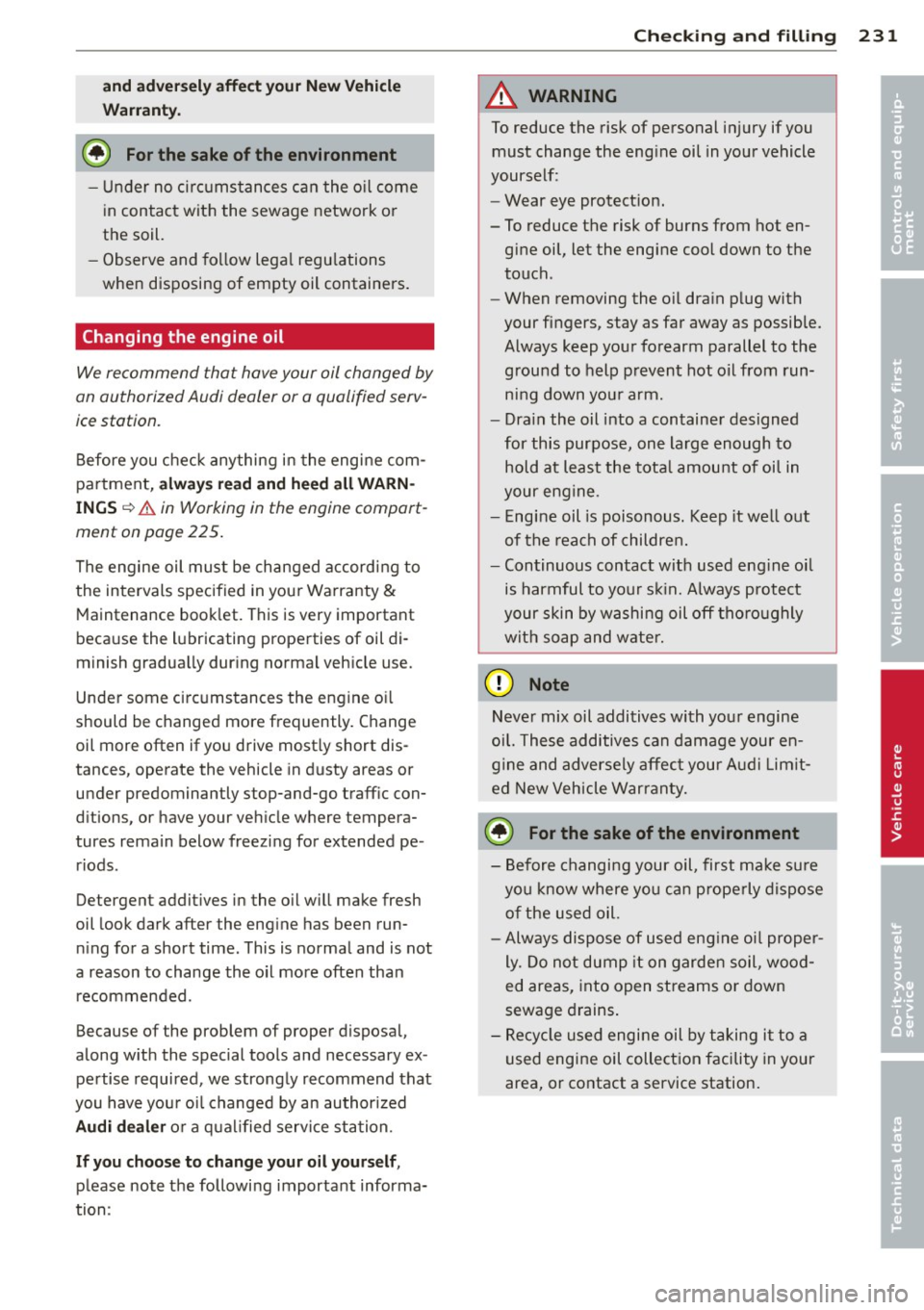
and adversely affect you r New Vehicle
Wa rranty .
@) For the sake of the environment
-Un der no ci rc u mstances can the o il come
in contact with the sewage network or
the soil.
- Observe and follow lega l regu lations
when disposing of empty oil containers .
Changing the engine oil
We recommend that have your oil changed by
an authorized Audi dealer or a qualified serv
ice station.
Before you check anything in the engine com
par tment,
a lways rea d and he ed all WARN
INGS
~ &. in Working in the engine compart
ment on page 225.
The engine oil must be changed according to
the intervals specified in your Warranty
&
Maintenance book let. This is very important
because the lubricating properties of oil di
minish gradua lly during normal vehicle use.
Under some circumstances the engine oi l
should be changed more frequently. Change
oil more often if you drive most ly short dis
tances, operate the vehicle in dusty areas or under predominantly stop-and-go traff ic con
d itions, or have your veh icle where tempera
tures remain below freezing for extended pe
riods.
Detergent additives in the o il w ill make fresh
oil look dark after the engine has been run n ing for a short time. This is normal and is not
a reason to change the oil more often than recommended.
Because of the problem of proper disposa l,
along w ith the special tools and necessary ex
pertise required, we strongly recommend that
you have you r oi l changed by an authorized
Audi de ale r o r a qual ified servi ce station.
If y ou c hoose to c ha ng e y our o il yo urse lf,
please note the followi ng important informa
tion :
Checkin g and fillin g 231
A WARNING
To reduce the risk of personal injury if you
must change the eng ine oil in your vehicle
yourself:
- Wear eye protect ion.
- To reduce the risk of burns from hot en- gine oil, let the engine cool down to the
touch.
- When removing the o il dra in p lug with
your fingers, stay as far away as possible. Always keep your forearm parallel to the
ground to help p revent hot oil from run
ning down you r arm.
- Dra in the oil into a container designed
for this purpose, one la rge enough to
hold at least the tota l amount of oi l in
your eng ine .
- Engine oil is poisonous. Keep it well out
of the reach of children.
- Continuous contact wit h used eng ine o il
is harmful to your s kin. A lways p rotect
your skin by washing oil off tho ro ughly
with soap and water.
@ Note
Neve r mix oil additives with your engine
oil. These additives can damage your en
g ine and adversely affec t you r Au di L imit
ed New Vehicle Warranty.
@ For the sake of the environment
- Before changing your oil, first make su re
you know where you c an properly dispose
o f the used oil.
- Always dispose of used eng ine oi l proper
ly. Do not dump it on garden soil, wood
ed areas, into open streams or down
sewage drains .
- Recycle used engine oil by taking it to a
used engine oil collect ion facility in your
area, or contact a service station.
•
•
Page 234 of 306
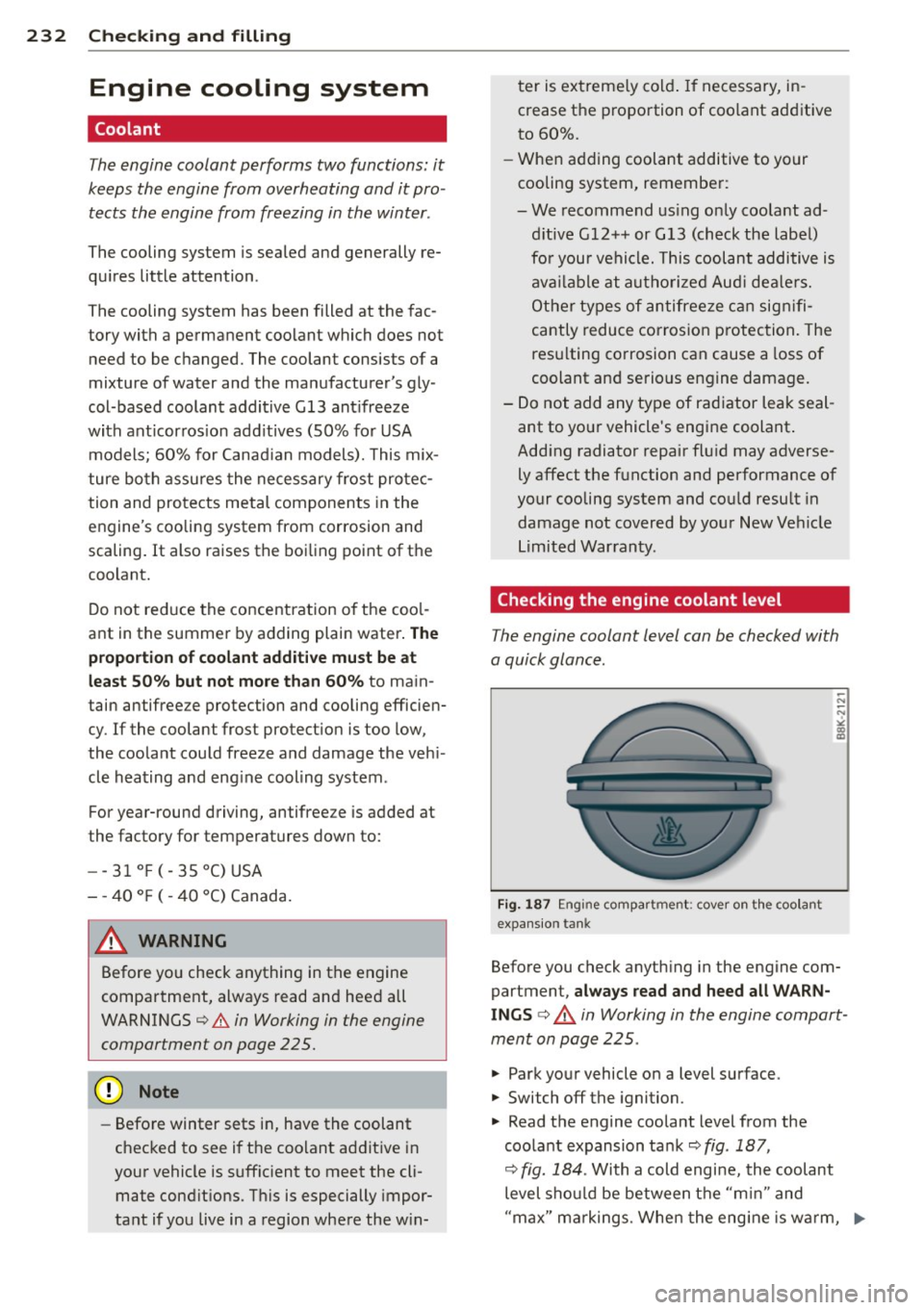
232 Check ing and filling
Engine cooling system
Coolant
The engine coolant performs two functions: it
keeps the engine from overheating and it pro
tects the engine from freezing in the winter .
The cooling system is sealed and generally re
quires little attention.
The cooling system has been filled at the fac
tory with a permanent coolant which does not need to be changed. The coolant consists of a
mixture of water and the manufacturer's gly
col-based coolant additive Gl3 ant ifreeze
with ant icorros ion add itives (50% for USA
models; 60% for Canad ian models). This mix
ture both assu res the necessary frost protec
tion and protects metal components in the
engine's cooling system from corrosion and
scaling. It also raises the boiling point of the
coolant.
Do not reduce the concentration o f the coo l
ant in the summer by adding plain water .
The
propo rtion of coolant add it iv e mu st be at
l eas t 50 % but not mo re than 6 0%
to main
tain antifree ze protection and cooling efficien
cy. If the coolant frost protect ion is too low,
the coolant could freeze and damage the veh i
cle heating and eng ine cooling system .
For year-round driving, antifree ze is added at
the factory for temperatures down to:
- -31°F(-35°C)USA
- - 40 ° F ( -40 °C) Canada.
A WARNING
Before yo u check anything in the engine
compartment, always read and heed all
WARNINGS
c:> &. in Working in the engine
compartment on page 225.
- Before winter sets in, have the coolant
checked to see if the coo lant addit ive in
your vehicle is suffic ient to meet the cli
mate cond itions. Th is is especially impor
tant if you live in a region where the w in- ter is extreme
ly cold . If necessary, in
crease the proportion of coo lant additive
to 60%.
- When adding coolant additive to your
cooling system, remember:
- We recommend us ing only coolant ad
d itive Gl2++ or G l3 (check the labe l)
fo r your vehicle. This coolant additive is
ava ilable at a utho rized Aud i dea le rs.
Other types of antifreeze can sign ifi
cantly reduce corros ion protection. The
res ulting corrosion can cause a loss of
coolant and serious engine damage.
- Do not add any type of radiator leak seal
ant to yo ur vehicle's engine coolant .
Add ing radiator repair flu id may adverse
ly affect the function and performance of
your cooling system and could resu lt in
damage not covered by your New Veh icle
Limited War ranty.
Checking the engine coolant level
The engine coolant level can be checked with
a quick glance .
Fig. 1 87 Engin e compar tmen t: cover on t he coo la nt
expansio n ta nk
Before you check anyth ing in the engine com
partment,
alwa ys read and heed all WARN
I NGS c:> &. in Working in the engine compart
ment on page 225 .
.. Park your vehicle on a level surface .
.. Switch off the ignition.
.. Read the engine coolant level from the
coola nt expansion tank
c:> fig . 187,
c:> fig. 184 . With a cold engine, the coolant
level shou ld be between the "min" and
"max" markings. When the eng ine is wa rm, ..,.
Page 235 of 306
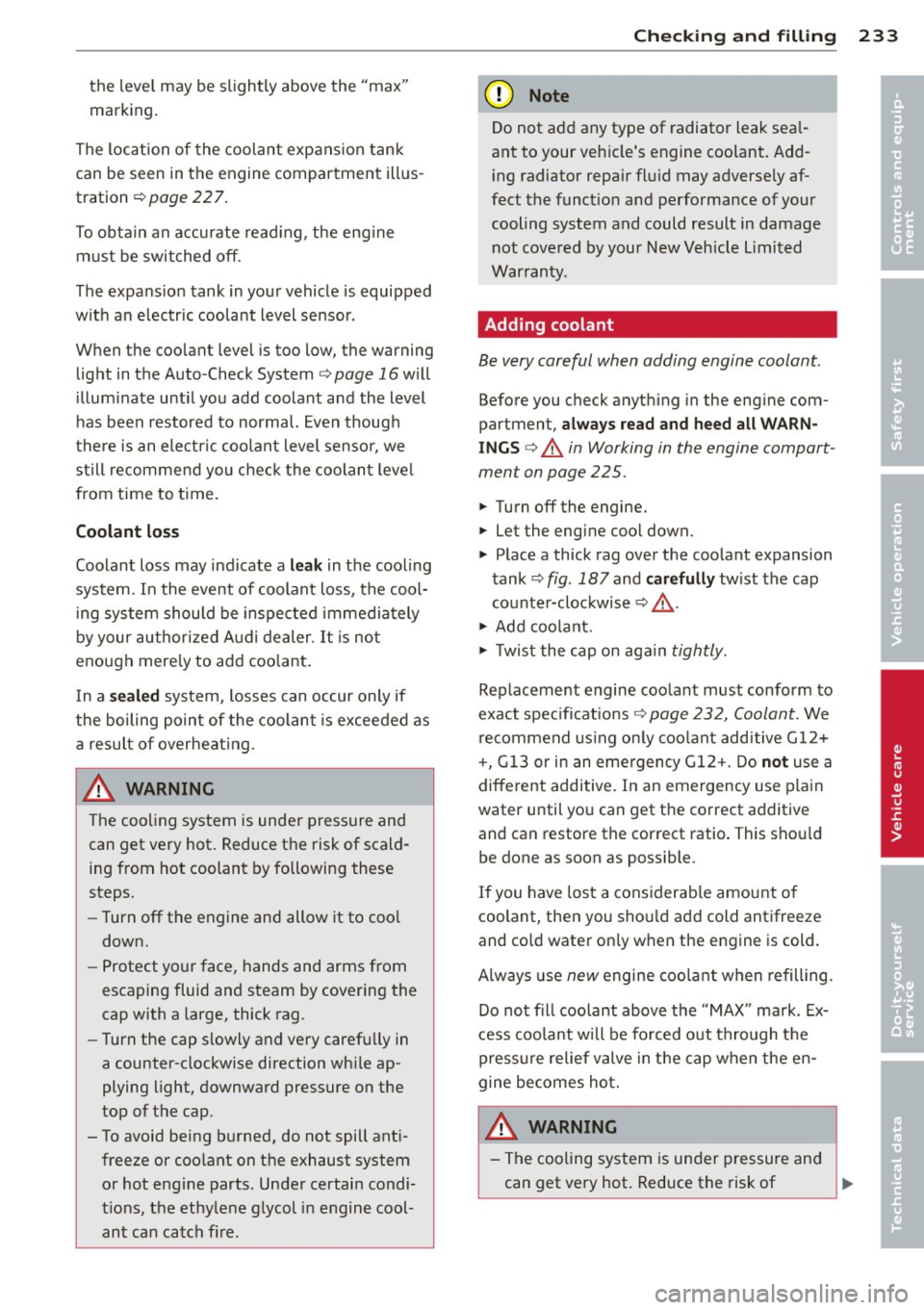
the level may be slightly above the "max"
marking .
The location of the coolant expansion tank
can be seen in the engine compartment illus
tration ¢ page 22 7.
To obtain an accurate reading, the engine must be switched
off.
The expansion tank in your vehicle is equipped
with an electric coolant level sensor.
When the coolant level is too low, the warning
light in the Auto-Check System ¢page 16will
illuminate until you add coolant and the level
has been restored to normal. Even though
there is an electric coolant level sensor , we
still recommend you check the coolant level
from time to time.
Coolant loss
Coolant loss may indicate a leak in the cooling
system. In the event of coolant loss, the cool
ing system should be inspected immediately
by your authorized Audi dealer.
It is not
enough merely to add coolant.
In a
sealed system, losses can occur only if
the boiling point of the coolant is exceeded as
a result of overheating.
& WARNING
The cooling system is under pressure and
can get very hot. Reduce the risk of scald
ing from hot coolant by following these
steps.
- Turn
off the engine and allow it to cool
down.
- Protect your face, hands and arms from
escaping fluid and steam by covering the
cap with a large, thick rag.
- Turn the cap slowly and very carefully in
a counter-clockwise direction while ap
plying light, downward pressure on the
top of the cap.
- To avoid being burned, do not spill anti freeze or coolant on the exhaust system or hot engine parts . Under certain condi
tions, the ethylene glycol in engine cool
ant can catch fire .
Checking and filling 233
@ Note
Do not add any type of radiator leak seal
ant to your vehicle's engine coolant. Add
ing radiator repair fluid may adversely af
fect the function and performance of your
cooling system and could result in damage not covered by your New Vehicle limited
Warranty .
Adding coolant
Be very careful when adding engine coolant.
Before you check anything in the engine com
partment,
always read and heed all WARN
INGS ¢ & in Working in the engine compart
ment on page 225 .
.,. Turn
off the engine .
.,. let the engine cool down.
.,. Place a thick rag over the coolant expansion
tank ¢ fig .
187 and carefully twist the cap
counter-clockwise ¢&_ .
.,. Add coolant.
.,. Twist the cap on again tightly.
Replacement engine coolant must conform to
exact specifications ¢ page
2 32, Coolant. We
recommend using only coolant additive G12+
+, G13 or in an emergency G12+. Do
not use a
different additive. In an emergency use plain
water until you can get the correct additive
and can restore the correct ratio. This should
be done as soon as possible.
If you have lost a considerable amount of
coolant, then you should add cold antifreeze
and cold water only when the engine is cold.
Always use new engine coolant when refilling.
Do not fill coolant above the "MAX" mark. Ex
cess coolant will be forced out through the pressure relief valve in the cap when the en
gine becomes hot.
A WARNING
- The cooling system is under pressure and
can get very hot. Reduce the risk of
II-
•
•
Page 236 of 306
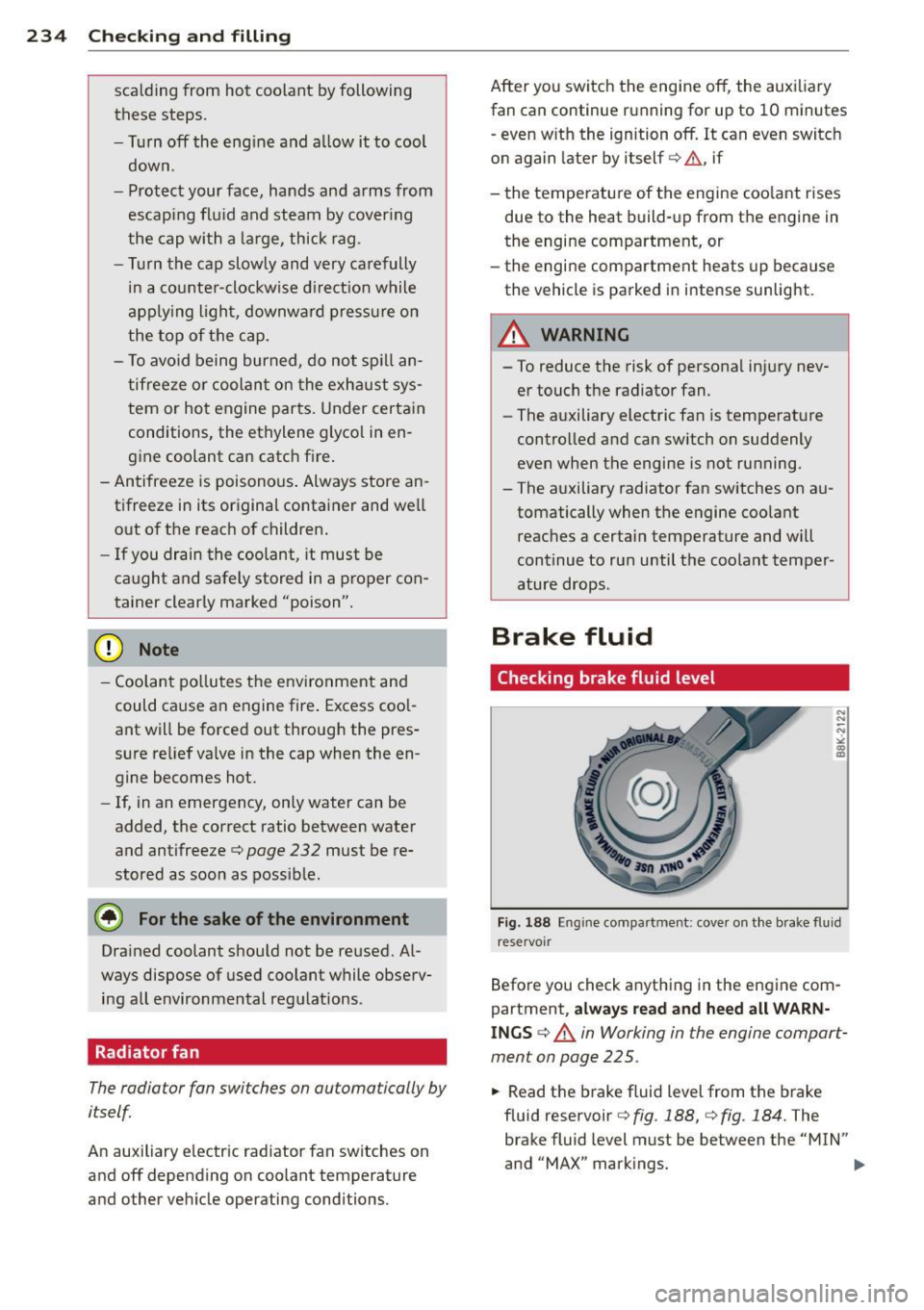
234 Checking and filling
scalding from hot coolant by following
these steps .
- Turn off the eng ine and a llow it to cool
down.
- Protect your face, hands and arms from escaping flu id and steam by cover ing
the cap with a large, thick rag .
- Turn the cap slowly and very carefully
i n a counter-clockwise direction while
apply ing l ight, downwa rd p ress ure on
the top of the cap .
- To avo id being burned, do not sp ill an
tifreeze or coolant on the exhaust sys
tem or hot engine parts . Under certain
conditions, the ethylene glyco l in en
gine coolant can catch f ire .
- Antifreeze is poisonous . Always store an
tifreeze in its or iginal container and we ll
out of the reach of children .
- If you drain the coolant, it must be
caught and safely stored in a proper con
tainer clear ly marked "poison".
@ Note
- Coolant po llutes the env ironment and
could cause an engine fire . Excess coo l
ant will be forced out through the pres
sure re lief valve in the cap when the en
gine becomes hot.
- If, in an emergency, on ly water can be
added, the correct ratio between water
and antifreeze
c::> page 232 must be re
stored as soon as possible .
@ For the sake of the environment
Drained coolant should not be re used. Al
ways dispose of used coolant while observ
ing all environmental regulat ions .
Radiator fan
The radiator fan switches on automatically by
itself
An auxiliary e lectr ic radiator fan switches on
and off depending on coolant temperature
and other vehicle operating cond itions. After you switch the engine off, the aux
iliary
fan can cont inue running for up to 10 minutes
- even w it h the ignition off. It can even switc h
on again later by itself
c::> .&. , if
- the temperatu re of the engine coo lant rises
due to the heat build-up from the engine in
the engine compartment, or
- the engine compartment heats up because
the vehicle is parked in intense sunlight.
A WARNING
-- To reduce the risk of persona l injury nev-
er touch the radiator fan.
- The a uxiliary electric fan is temperat ure
contro lled and can sw itch on suddenly
even when the engine is not running.
- The auxiliary radiator fan switches on a u
tomatically when the engine coo lant
reaches a certain temperature and will
continue to run until the coolant temper
ature drops .
Brake fluid
Checking brake fluid level
Fig. 1 88 En gin e compa rtme nt: cove r on t he brake fluid
reservoi r
Before you check anything in the engine com
partment,
always read and heed all WARN
INGS c:> A in Working in the engine compart
ment on page 225.
.,. Read the brake fluid level from the brake
fluid reservoir
c::> fig. 188, c:> fig . 184. The
brake fluid level must be between the "MIN"
and "MAX" markings.
IJ>
Page 237 of 306
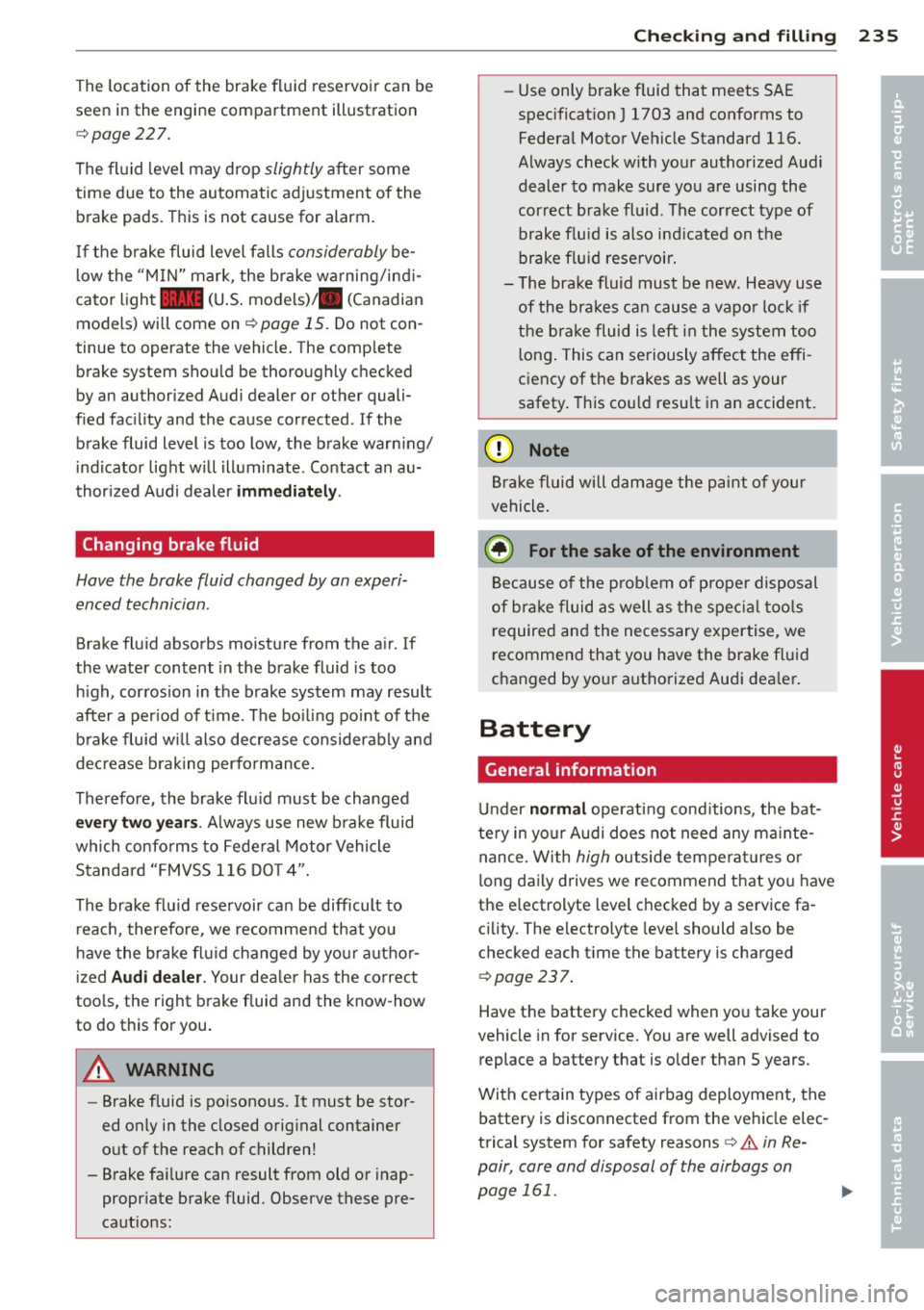
The location of the brake fl uid reservo ir can be
seen in the engine compartment illustration
c::> page227.
The fl uid level may drop slightly after some
time due to the automatic adjustment of the
brake pads. This is not cause for alarm .
If the brake fluid level falls considerably be
l ow the "MIN" mark, the bra ke wa rning/ind i
cator light
1111 (U .S . models)/ . (Canadian
models) will come on
c::> page 15. Do not con
tinue to operate the vehicle. The comp lete
brake system sho uld be thoroughly checked
by an author ized Audi dealer or other quali
fied fac ility and the cause corrected . If the
brake fluid level is too low, the brake warn ing/
i ndicator light w ill illuminate . Contact an au
thor ized Audi dealer
imm ediately .
Changing brake fluid
Have the brake fluid changed by an experi
enced technician .
Brake fluid absorbs moisture from the a ir. If
the water content in the brake fluid is too
h igh, corrosion in the brake system may result
after a per iod of t ime . The bo iling po int of t he
brake fluid w ill also decrease consider ably and
dec rease b raking per formance.
Therefore, the brake flu id must be changed
ever y two years . Always use new b rake fluid
whi ch confo rms to Fede ral Motor Vehicle
Standard "FMVSS 1 16 DO T 4".
The brake flu id rese rvoir ca n be difficult to
r eac h, therefo re , we re commend that yo u
have the brake fl uid changed by y our autho r
i z ed
Audi dealer . Your deale r has the correct
too ls, the right brake fluid and the know -how
to do this for you .
A WARNING
-Brake fluid is po isonous . It must be stor
ed only in the closed orig inal container
out of t he reac h of children!
- Brake fa ilure can result from old o r inap
propr iate brake fluid. Observe these pre
caut ions:
Checkin g and fillin g 235
-Use only brake f luid that meets SAE
spec ificat ion
J 1703 and conforms to
Federal Motor Ve hicle Standard 116.
Always check with your autho rized Audi
dealer to make sure yo u are using the
correct brake fluid . The correct type of
brake f lu id is also ind icated on the
brake flu id rese rvoi r.
- The bra ke fluid must be new. Heavy us e
of the brakes can cause a vapo r lock if
the b ra ke fluid is left i n the system too
l ong . This can se riously affec t the effi
ciency of the b rakes as well as your
safety . This co uld resu lt in an accident.
(D Note
B rak e fluid wi ll damage the pa int o f you r
vehicle .
~ For the sake of the environment
Because o f the p rob lem of pro per disposal
of bra ke fluid as well as the spe cial too ls
r equired an d the necessary exper tise, we
r ecommend that yo u have the brake flu id
changed by yo ur authorized Aud i dea le r.
Battery
General information
U nder normal ope ra ti ng cond itions , the bat
te ry in yo ur Audi doe s not need any ma inte
nance. With
high outside tempera tures or
l ong daily drives we recommend that you have
the e lectrolyte level checked by a service fa
c ili ty. The electrolyte leve l should a lso be
checked each t ime the battery is charged
c:> page 237.
Have the battery checked when yo u take your
vehicle in for service. You are well advised to
replace a batte ry that is older than 5 years .
Wi th certain types of airbag deployment, the
battery is disconnected from the vehicle elec
trical system for safety reasons
c> & in Re
pair , care and disposal of the airbags on
page 161.
~
•
•
Page 239 of 306
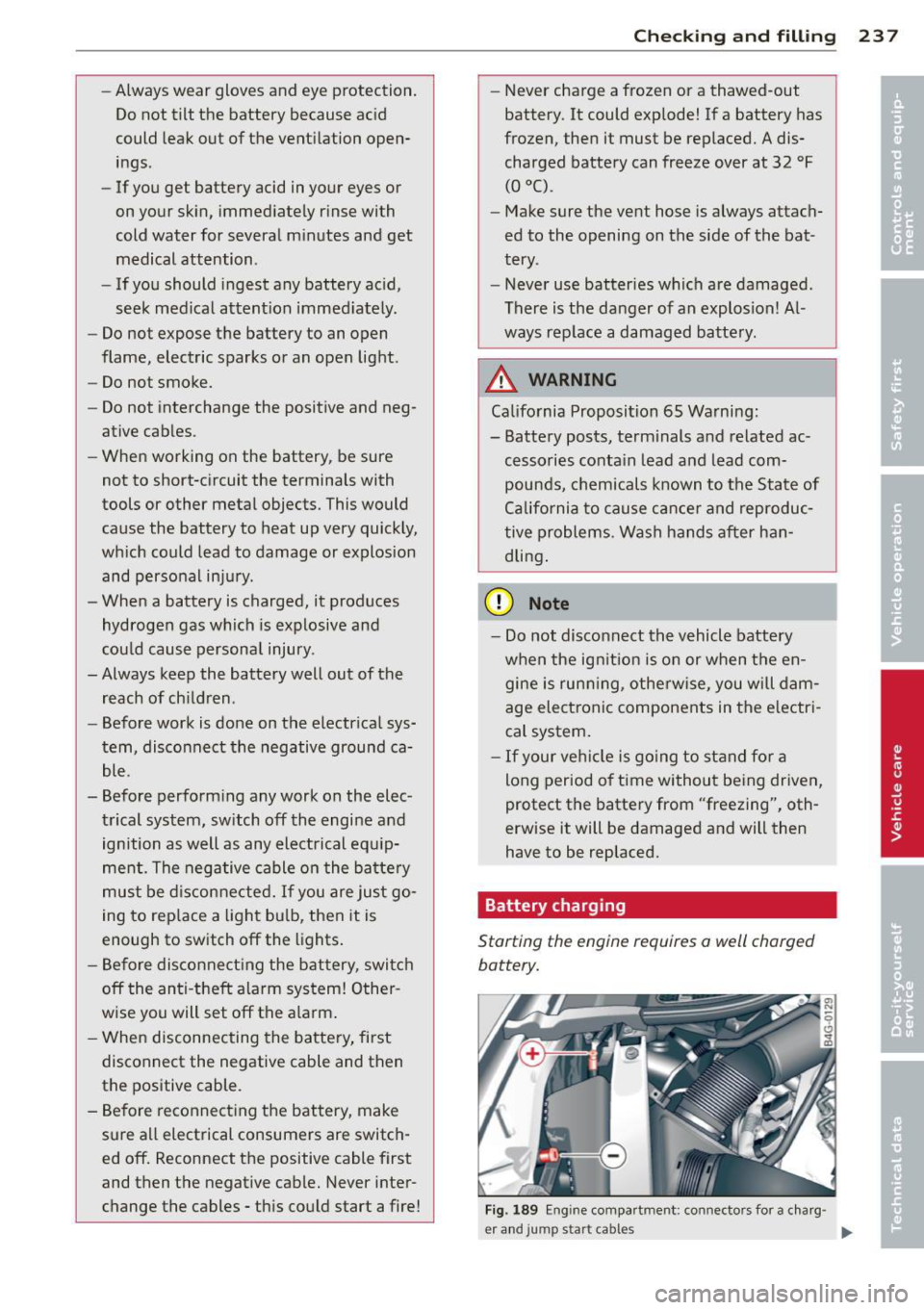
-Always wear gloves and eye protection.
Do not tilt the battery because acid
could leak out of the ventilation open
ings .
- If you get battery acid in your eyes or
on your skin, immediately rinse with
cold water for several minutes and get
medical attention.
- If you should ingest any battery acid,
seek medical attention immediately.
- Do not expose the battery to an open
flame, electric sparks or an open light .
- Do not smoke.
- Do not interchange the positive and neg-
ative cables .
- When working on the battery, be sure
not to short-circuit the terminals with
tools or other metal objects. This would cause the battery to heat up very quickly,
which could lead to damage or explosion
and personal injury .
- When a battery is charged, it produces
hydrogen gas which is explosive and
could cause personal injury .
- Always keep the battery well out of the
reach of children .
- Before work is done on the electrical sys
tem, disconnect the negative ground ca
ble.
- Before performing any work on the elec trical system, switch off the engine and
ignition as well as any electrical equip
ment. The negative cable on the battery
must be disconnected.
If you are just go
ing to replace a light bulb, then it is
enough to switch off the lights.
- Before disconnecting the battery , switch
off the anti-theft alarm system! Other
wise you will set off the alarm.
- When disconnecting the battery, first
disconnect the negative cable and then
the positive cable.
- Before reconnecting the battery, make
sure all electrical consumers are switch
ed off. Reconnect the positive cable first
and then the negative cable. Never inter
change the cables - this could start a fire!
Checking and filling 237
- Never charge a frozen or a thawed-out
battery . It could explode! If a battery has
frozen, then it must be replaced. A dis
charged battery can freeze over at 32 °F
(0 oc).
-Make sure the vent hose is always attach
ed to the opening on the side of the bat
tery .
- Never use batteries which are damaged.
There is the danger of an explosion! Al
ways replace a damaged battery .
A WARNING
California Proposition 65 Warning:
- Battery posts, terminals and related ac
cessories contain lead and lead com
pounds, chemicals known to the State of
California to cause cancer and reproduc
tive problems . Wash hands after han
dling .
(D Note
-Do not disconnect the vehicle battery
when the ignition is on or when the en
gine is running, otherwise, you will dam
age electronic components in the electri
cal system.
- If your vehicle is going to stand for a
long period of time without being driven,
protect the battery from "freezing", oth
erwise it will be damaged and will then
have to be replaced.
Battery charging
Start ing the engine requires a well charged
battery.
Fig . 189 Eng in e compart ment : co nnecto rs for a charg ·
e r and jump st art cable s
1111>
Page 240 of 306
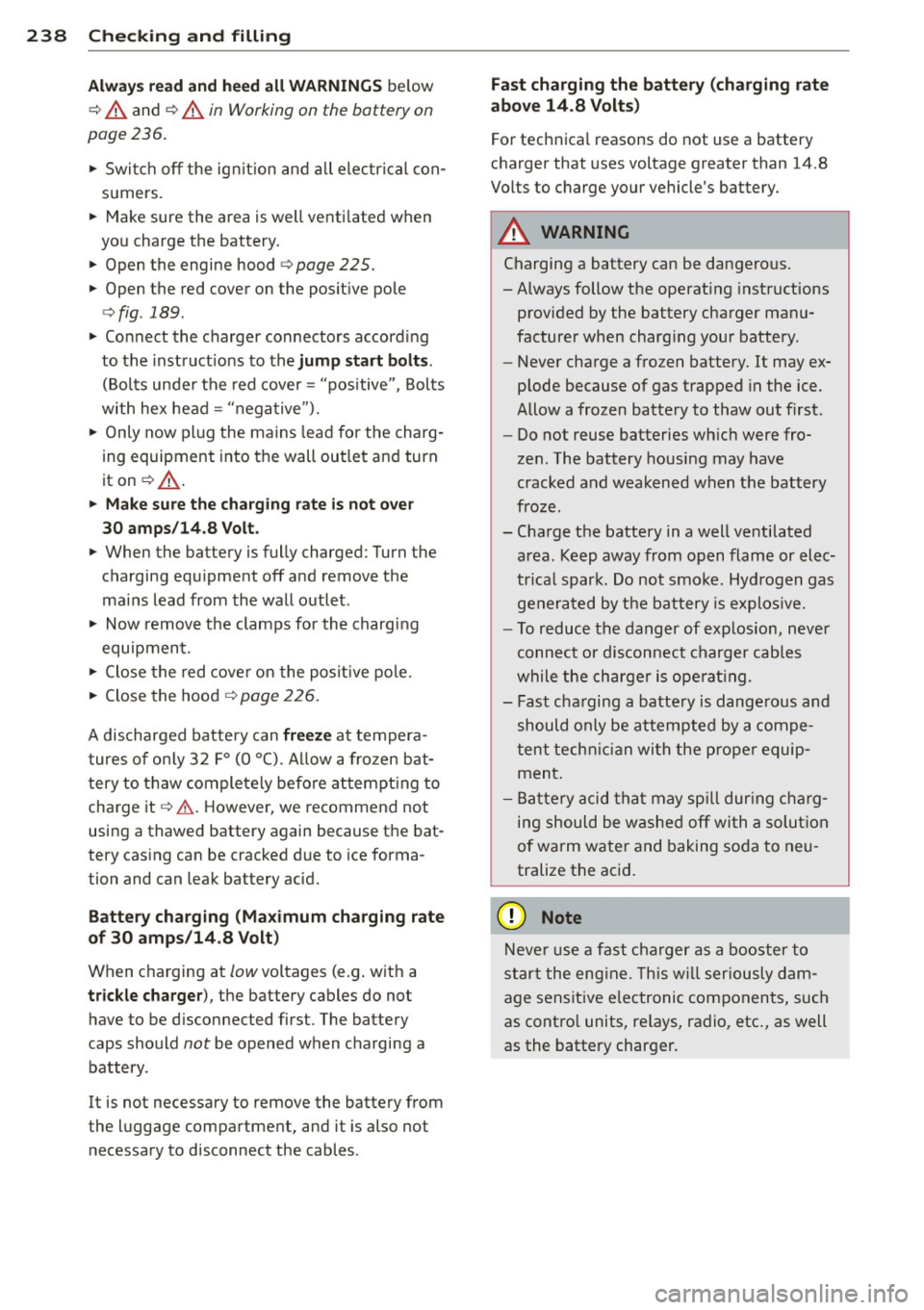
238 Check ing and filling
Al ways read and h eed all WARNING S below
¢ A and ¢ A in Working on the bottery on
page 236.
.,. Switch off the ignit ion and all electrical con
sumers .
.,. Make sure the area is well venti lated when
yo u charge the battery.
.,. Open the engine hood
¢page 225.
.,. Open the red cover on the posit ive pole
¢ fig . 189 .
.,. Connect the charger connectors accord ing
to the instruct ions to the
jump start bol ts.
(Bolts under the red cover= "positive", Bolts
with hex head= "negative") .
.,. Only now plug the mains lead for the charg
ing equipment into the wall outlet and turn
it on ¢.&_ .
.,. Ma ke s ure the charging ra te i s n ot o ver
30 amp s/14. 8 Volt.
.,. When the battery is fully charged: Turn the
charging equ ipment off and remove the
mains lead from the wall outlet .
.,. Now remove the clamps for the charging
equipment.
.,. Close the red cove r o n the pos it ive pole.
.,. Close the hood
¢ page 226.
A discharged batte ry can fre eze at tempera
tures of on ly 32 F
0 (0 °C). A llow a frozen bat
tery to thaw completely befo re attempt ing to
charge it¢
A . Howeve r, we recommend not
using a thawed battery again because the bat
tery cas ing can be cracked d ue to ice forma
tion and can leak battery acid.
Batt ery charging (Ma ximum charging rate
of 30 amp s/14 .8 Volt)
When charging at low voltages (e.g . w ith a
tr ickle ch arger ), the battery cables do not
have to be d isconnected first. The battery
caps should
not be opened when charging a
battery .
It is not necessary to remove the battery from
the luggage compartment, and it is also not
necessary to disconnect the cables .
Fast charging the battery (ch arging rate
a bo ve 14 .8 V olts)
For technical reasons do not use a battery
charger that uses voltage greater than 14.8
Volts to charge your vehicle's battery.
A WARNING
--Charging a battery can be dangerous .
-Always follow the operating instructions
provided by the battery charger manu
facturer when charg ing your battery .
- Never charge a frozen battery. It may ex
plode because of gas trapped in the ice.
Allow a frozen battery to thaw out f irst .
- Do not reuse batteries wh ich were fro
zen. The battery housing may have
cracked and weakened when the battery
froze.
- Charge the battery in a well ventilated area. Keep away from open flame or elec
tr ica l spark. Do not smoke. Hydrogen gas
generated by the battery is explos ive .
- To reduce the danger of explosion, never
connect or d isconnect charger cab les
while the charger is ope rat ing .
- Fast charging a battery is dangerous and
should only be attempted by a compe
tent techn ic ian wi th the proper equip
ment .
- Battery acid that may sp ill dur ing cha rg
ing should be washe d off wi th a solut ion
of wa rm water and baking soda to neu
tralize the ac id.
(D Note
Neve r use a fast charger as a booster to
start the eng ine. Th is w ill seriously dam
age sensit ive e lectronic components, such
as contro l units, re lays, radio, etc., as well
as the battery charger.
Page 241 of 306
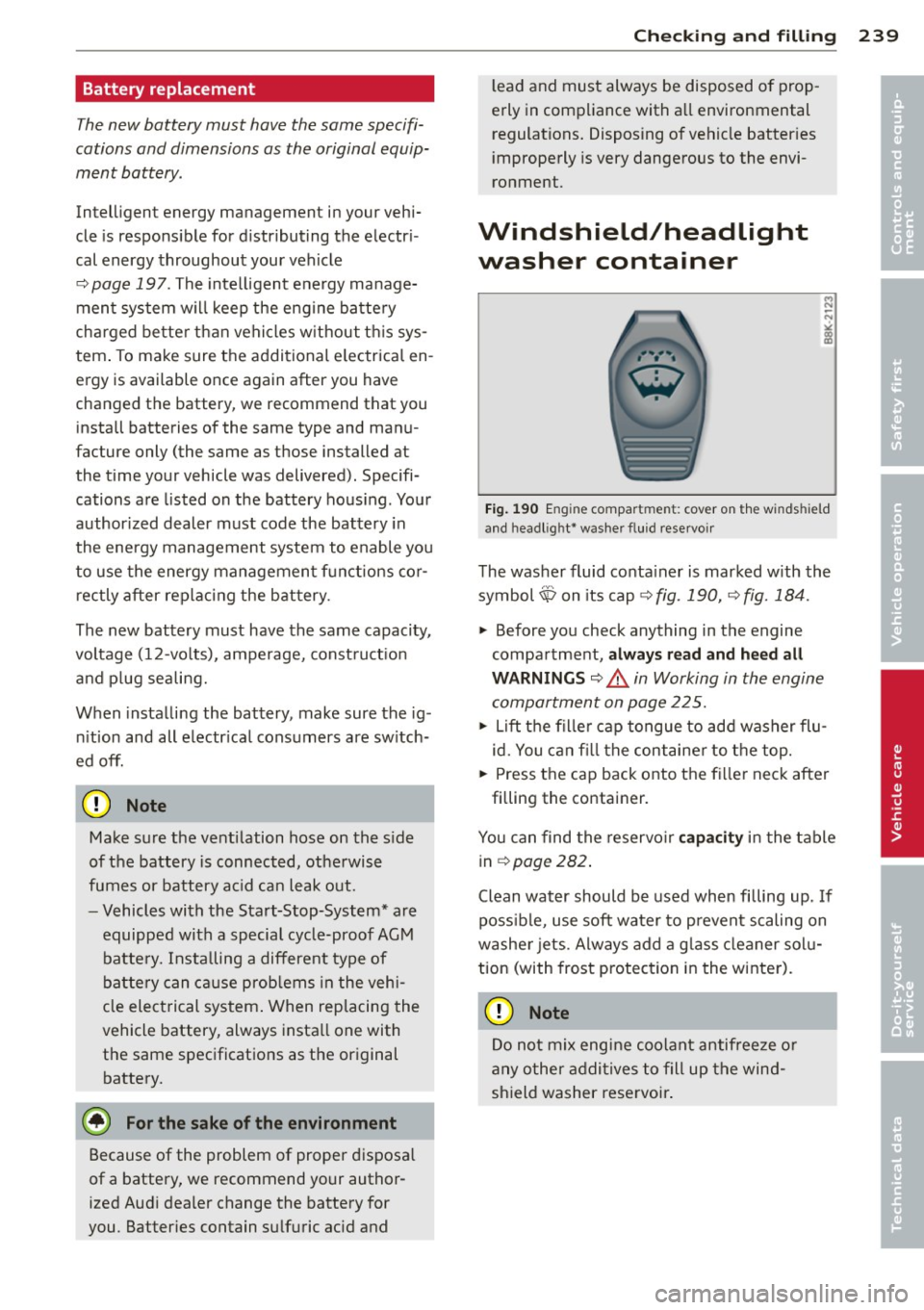
Battery replacement
The new battery must have the same specifi
cations and dimensions as the original equip
ment battery.
Intell igent energy management in your vehi
cle is respons ible for d istributing the electri
cal energy throughout your vehicle
~ page 197. The intel ligent energy ma nage
ment system w ill keep the eng ine batte ry
charged be tte r than vehicles w ithout t his sys
tem . To make sure the additional e lectrical en
ergy is available once again after you have
changed the battery, we recommend that you
install batteries of the same type and man u
facture only (the same as those installed at
the time your vehicle was delivered). Specifi
cations a re listed on the battery hous ing . Your
author ized dealer must code the battery in
the energy management system to enable you
to use the energy managemen t fu nctions co r
rectly a fter replacing the battery .
The new battery must have the same capacity,
voltage (12-vo lts), a mperage, construct ion
and p lug sealing.
When installing the battery , make sure the ig
n ition and all e lectr ica l cons umers are sw itch
ed off.
CD Note
Make sure the ventilation hose on the s ide
of the battery is connected, ot herwise
fumes or battery ac id can leak out.
- Vehicles with the Start-Stop-System* are
equipped with a specia l cycle-proof AGM
batte ry. Insta lling a different type of
batte ry can c ause prob lems in the vehi
cle electrical system . When rep lacing the
vehicle battery, always insta ll one with
the same specifications as the original battery.
@ For the sake of the environment
Because of the problem of proper disposa l
of a battery, we recommend your author
ized Aud i dea ler change the battery for
you. Batter ies contain sulf uric ac id and
Checkin g and fillin g 239
lead and must always be disposed o f prop
erly in compliance with a ll environmental
regulations. Disposing of vehicle batter ies
i mproperly is very dangerous to the envi
ronment.
Windshield/headlight
washer container
Fi g. 1 90 Engine compar tment: cover on th e windshield
and headl ig ht* washe r flu id reservo ir
The washer fluid conta iner is marked w ith the
symbol ~ on its cap
~ fig . 190, ~fig. 184.
... Before you check anything in the engine
compartment,
always r ead and heed all
WARNINGS ¢ _& in Working in the engine
compartment on page 225.
... Lift the fil le r cap tongue to add washer flu
id. You can fi ll the containe r to the top.
... Press the cap back onto the fi lle r neck after
filling the container.
You can find the reservo ir
cap acit y in the table
in
¢ page 282.
Clean water should be used when filling up. If
poss ible, use soft wa ter to prevent scaling on
washer jets . Always add a g lass cleaner solu
tion (with frost protection in the winter).
CD Note
Do not mix engine coo lant antifreeze or
any o ther additives to fill up t he wind
sh ield washer reservoir .
•
•